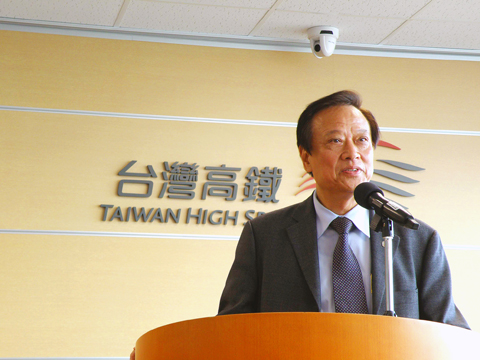One day after Taiwan High Speed Rail Corp (THSRC, 台灣高鐵) chief executive Ou Chin-der (歐晉德) assumed the company’s chairmanship on Tuesday last week, he told media he did not feel an ounce of joy.
He dismissed the media’s depiction of THSRC as “a rotten mess,” but expressed hope that salvaging the firm would be the final battle of his career. He hoped that under his leadership, the company could break even next year and turn a profit after 10 or 15 years.
Those aspirations may take a lot more than a board reshuffle and lower interest rates to achieve, although Ou has the government’s backing for a refinancing plan of NT$390 billion (US$12 billion).

PHOTO: TSENG HUNG-JU, TAIPEI TIMES
Created in 1998 with capital of NT$105.3 billion, the company, which operates the 345km bullet train service — one of the world’s biggest build-operate-transfer (BOT) projects — risks default on debt payments in November if its finances remain unchanged.
THSRC has more assets than debts — NT$416.8 billion versus NT$389.9 billion — and had posted NT$70.2 billion in losses as of June this year, equivalent to 67 percent of its capital.
To finance the construction of the rail project, the company took out two syndicated loans — one for NT$308.3 billion and one for NT$65.5 billion — with interest rates of between 2.6 percent and 2.8 percent. It also raised funds by issuing US$300 million in euro-convertible bonds that may begin to be cashed in next year.
THSRC blames its financial woes mainly on interest payments and depreciation costs that consume the bulk of its revenue.
“For each NT$100 earned, the company has to pay NT$36 in interest and another NT$40 in depreciation costs,” spokesman Ted Chia (賈先德) said. “The burden renders creating a balanced sheet difficult, if not utterly impossible.”
A bank official involved in the loan negotiations said on Friday that the company’s interest amounts to NT$10.1 billion a year and that without financial improvement, it will take THSRC decades to pay off its debts.
“The company makes about NT$2 billion a month, enough to cover interest but not enough to pay principal due soon,” the official said on condition of anonymity.
To address the cash shortage, THSRC is seeking to lower the interest rates to below 2 percent. Prospective lenders prefer a milder cut, in light of the company’s financial profile, he said.
Bank of Taiwan (臺灣銀行) chairwoman Susan Chang (張秀蓮), who is organizing the new NT$390 billion loan to THSRC, told a legislative hearing on Thursday the rate cut would not exceed 1 percentage point.
A bigger cut would dampen the willingness of banks to take part in the syndicate and thwart the refinancing plan, Chang said. She expected to settle the matter next month to help THSRC meet a debt obligation in mid-November.
The rail company’s five founding shareholders — Continental Engineering Corp (大陸工程), Teco Electric and Machinery Co (東元電機), Evergreen Marine Corp (長榮海運), Pacific Electric Wire and Cable Co (太平洋電線電纜) and Fubon Bank (富邦銀行) — have washed their hands of THSRC debts after previous investments bore no fruit. But the legislature’s Finance Committee passed a resolution on Thursday requiring the five shareholders to cosign the new loan.
Depreciation costs pose another headache, having eaten away NT$42.4 billion as of June this year, company data showed.
THSRC is due to concede the rail project in 2033, meaning it has only 26 years to absorb all depreciation costs from the beginning of operation in January 2007 to the end of the BOT contract.
Ou said that most equipment can last for more than 60 years and seeking more favorable depreciation terms tops his agenda to put the company on the right track.
To that end, the new chairman also suggested the government should consider extending the BOT contract from the original 35 years to allow the company more time to reverse its finances.
The suggestion promises the quickest way to bring down depreciation costs. The Ministry of Transportation and Communications has said it is better to focus on interest first and address depreciation and other issues afterwards.
Still, others warn that the root of the company’s predicament lies elsewhere and the refinancing plan will offer a respite rather than a solution.
Former THSRC chairperson Nita Ing (殷琪) said in a recent interview that she made serious mistakes with bidding for the rail contract, one of which was an overly optimistic estimation of passenger volume.
Ing said she set the number at 230,000 passengers a day when joining the bid for the BOT project 15 years ago, guided by GDP growth and traveler loads at the time at Taipei’s Songshan Airport.
The actual figure has turned out to be roughly 80,000 passengers a day. Ing attributed the disparity partly to the industrial exodus of the last 12 years, which shrank the working population by 2 million and hurt domestic airlines as well as THSRC.
Chinese Nationalist Party (KMT) Legislator Lee Hung-chun (李鴻鈞), a senior member of the legislature’s Transportation Committee, said that the high-speed rail, designed to serve business travelers and tourists, has a slim chance of making profits if there are no supporting public works plans.
Lee said the company had counted on land development projects along the rail line to help boost its revenue but the expectation remains little more than wishful thinking today.
The situation could change, however, if the government takes over the high-speed rail and launches a bold spending program to make the bullet train service part of people’s life.
To that end, the government should subsidize transfer buses and fund land development and other public works projects in towns near bullet train stations so the high-speed rail could be more fully utilized while rural areas are urbanized, the lawmaker said.
“Projects of such scale entail long-term planning and financing, not to mention the legal barriers involved,” Lee said. “The private sector does not have sufficient resources, financially or legally.”
Lee voiced concern that a bailout package of anything less than full government control of THSRC would not be able to fix the problem once and for all.
The government has made clear it does not want to own the company or put more money into it, but will help keep it running after Ou replaced Ing.
With a 38 percent stake in the company, the government will next seek to win a majority of seats in its board of directors in November to dominate its policymaking with a view to listing the firm on the local bourse in the future.
Liang Kuo-yuan (梁國源), president of Polaris Research Institute (寶華綜合經濟研究院), said he agreed with the government on keeping the high-speed rail a self-liquidating project like highways, which can use its own means to make up for losses and yield a profit on the initial outlay of investment.
This way, the high-speed rail would not add a burden to state coffers as it fulfills its purpose of linking Taipei and Kaohsiung, he said.
Liang, like Ing, said that the industrial migration to China is sapping Taiwan’s economy and denting demand for the high-speed rail.
But the academic said the administration is working to foster their return through tax cuts and deregulating cross-strait trade.
“Apart from facilitating syndicated loans, the government can help THSRC by improving the macroeconomic environment, thereby boosting business travel and ticket sales,” Liang said.
Despite the downturn, THSRC narrowed its losses by 75 percent to NT$2.7 billion in the first half of this year from the same period last year, while ticket revenue rose to NT$11.5 billion, from NT$10.8 billion.
Passenger volume dropped to 2.71 million last month, from 2.95 million in July, on falling demand as Typhoon Morakot undermined demand for popular tourist spots in southern Taiwan, the company said.
Paradoxically, the company’s financial crisis may open an opportunity for all parties to sit down and correct past mistakes.
Liang said project planners tend to underscore the bright side of things and play down negative factors and that probably accounted for the discrepancy between passenger numbers now and the projections made 15 years ago.
“THSRC is indeed embroiled in deep trouble that must be handled with care because much is at stake,” he said. “The government and the company must demonstrate more prudence and adopt a forward-looking, yet realistic perspective when resetting contract terms.”

It was late morning and steam was rising from water tanks atop the colorful, but opaque-windowed, “soapland” sex parlors in a historic Tokyo red-light district. Walking through the narrow streets, camera in hand, was Beniko — a former sex worker who is trying to capture the spirit of the area once known as Yoshiwara through photography. “People often talk about this neighborhood having a ‘bad history,’” said Beniko, who goes by her nickname. “But the truth is that through the years people have lived here, made a life here, sometimes struggled to survive. I want to share that reality.” In its mid-17th to

‘MAKE OR BREAK’: Nvidia shares remain down more than 9 percent, but investors are hoping CEO Jensen Huang’s speech can stave off fears that the sales boom is peaking Shares in Nvidia Corp’s Taiwanese suppliers mostly closed higher yesterday on hopes that the US artificial intelligence (AI) chip designer would showcase next-generation technologies at its annual AI conference slated to open later in the day. The GPU Technology Conference (GTC) in California is to feature developers, engineers, researchers, inventors and information technology professionals, and would focus on AI, computer graphics, data science, machine learning and autonomous machines. The event comes at a make-or-break moment for the firm, as it heads into the next few quarters, with Nvidia CEO Jensen Huang’s (黃仁勳) keynote speech today seen as having the ability to

The battle for artificial intelligence supremacy hinges on microchips, but the semiconductor sector that produces them has a dirty secret: It is a major source of chemicals linked to cancer and other health problems. Global chip sales surged more than 19 percent to about US$628 billion last year, according to the Semiconductor Industry Association, which forecasts double-digit growth again this year. That is adding urgency to reducing the effects of “forever chemicals” — which are also used to make firefighting foam, nonstick pans, raincoats and other everyday items — as are regulators in the US and Europe who are beginning to

NEXT GENERATION: The company also showcased automated machines, including a nursing robot called Nurabot, which is to enter service at a Taichung hospital this year Hon Hai Precision Industry Co (鴻海精密) expects server revenue to exceed its iPhone revenue within two years, with the possibility of achieving this goal as early as this year, chairman Young Liu (劉揚偉) said on Tuesday at Nvidia Corp’s annual technology conference in San Jose, California. AI would be the primary focus this year for the company, also known as Foxconn Technology Group (富士康科技集團), as rapidly advancing AI applications are driving up demand for AI servers, Liu said. The production and shipment of Nvidia’s GB200 chips and the anticipated launch of GB300 chips in the second half of the year would propel